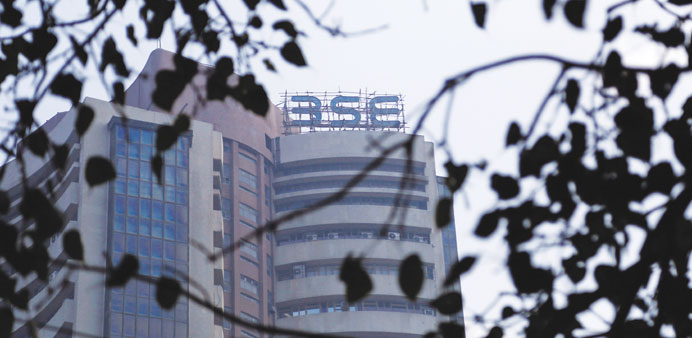The Bombay Stock Exchange building is seen through foliage in Mumbai. The Sensex soared 1.5% to 28,114.56 points yesterday.
Bloomberg/Mumbai
Indian stocks climbed the most in six weeks after the government moved to expand the size of an annual capital injection into state-owned lenders amid an increase in stressed assets.
State Bank of India surged the most since May, while ICICI Bank, the largest private lender, rose the most in three months after reporting a record quarterly profit. Dr Reddy’s Laboratories climbed to an all-time high after its results beat forecasts, while Hero MotoCorp, a motorcycle maker, jumped the most in nine months.
The S&P BSE Sensex soared 1.5% to 28,114.56 at the close, erasing a weekly and monthly loss. The ministry wants to raise the cash to be injected into lenders in the year to March 31 to Rs120.1bn ($1.87bn), documents tabled in parliament yesterday show. Bad debts at state-owned banks climbed to a 13-year high and capital ratios declined, according to central bank data.
“The capital infusion plan as well as hope of a rate cut in Tuesday’s monetary policy meeting” spurred gains in banks, Vaibhav Sanghavi, managing director at Ambit Investment Advisors in Mumbai, said by phone.
State Bank soared 5.2%, the best performer on the Sensex. Union Bank of India jumped 7.6%. United Bank of India rallied 4.5%, Oriental Bank of Commerce surged 4.4% and Indian Overseas Bank added 4.1%.
The government set aside Rs69.9bn for lenders in the year ended March 31, which was the lowest total since at least 2009. The proposed increase needs approval from lawmakers.
ICICI Bank increased 3.9%, the most since May 8. First-quarter profit of Rs29.8bn exceeded the median estimate of Rs29.2bn in a Bloomberg survey.
Larsen & Toubro, the most-valuable engineering firm, said first-quarter profit declined 22% to Rs7.01bn, missing the Rs8.05bn estimated by analysts. Earnings were announced after trading ended. The shares rose 1%.
Twelve of the 18 Sensex companies, or 67%, that have posted results for the June quarter have matched or exceeded estimates, compared with 40% in the March quarter.
The Sensex erased the week’s losses after Federal Reserve on Wednesday refrained from providing timing for raising the near-zero US rates that have helped fuel capital flows into emerging markets. Foreigners have injected $886mn into Indian stocks this month, the only inflows among eight Asian markets tracked by Bloomberg.
“On the capital flows, we seem to be doing alright,” Mahesh Nandurkar, a strategist at CLSA Asia-Pacific Markets, said in an interview on Thursday. “India stands out in the sense that it has relatively lower exports or exposure to the rest of the world.”
The Sensex has gained 2.2% this year and trades at 15.7 times projected 12-month earnings. The MSCI Emerging Markets Index is valued at a multiple of 11.2.
Meanwhile the rupee fell 0.8% in July to 64.1350 a dollar, according to prices from local banks compiled by Bloomberg. It declined 0.2% yesterday.
India’s 10-year bonds completed a monthly advance on optimism a drop in oil prices and an improvement in the monsoon will slow inflation and give the central bank room to keep interest rates unchanged next week.
Consumer prices rose more than analysts predicted in June, led by an increase in food costs, but a late pick-up in seasonal rains has allayed concerns that those gains will accelerate. Brent crude slumped 17% in July, the biggest monthly drop of 2015, easing pressure on inflation in a nation that relies on imports to meet about 80% of its oil needs. The rupee weakened amid slowing demand for emerging-market currencies as the US prepares to raise borrowing costs.
“With lower crude oil prices and good monsoons, the risk of a spike in inflation has waned,” said Harish Agarwal, a Mumbai-based fixed-income trader at the local unit of South African lender FirstRand. Bonds are likely to rally going forward on expectations of lower inflation, he said.
The yield on the 2025 notes fell one basis point Friday and five basis points in July to 7.81% in Mumbai, prices from the central bank’s trading system show. That’s the biggest monthly decline for the benchmark sovereign bond yield since May.
Reserve Bank of India Governor Raghuram Rajan, who reviews monetary policy on Aug. 4, flagged deficient rains, oil prices and external volatility as risks to inflation in June, when he cut the benchmark rate for the third time this year to 7.25%. Only three of 39 economists surveyed by Bloomberg see a reduction next week, with the rest expecting no change.

